 klaus-michael schneider
klaus-michael schneider
Keywords: san andres providencia y santa catalina | colombia | saltire | providencia | santa catalina | serranilla bank |
Links: FOTW homepage | search | disclaimer and copyright | write us | mirrors

Last modified: 2021-08-26 by  klaus-michael schneider
klaus-michael schneider
Keywords: san andres providencia y santa catalina | colombia | saltire | providencia | santa catalina | serranilla bank |
Links: FOTW homepage |
search |
disclaimer and copyright |
write us |
mirrors
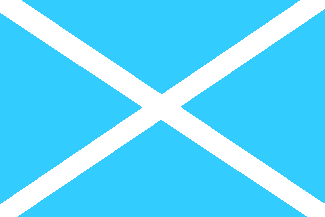
image by Andres Villaveces, 22 December 1999
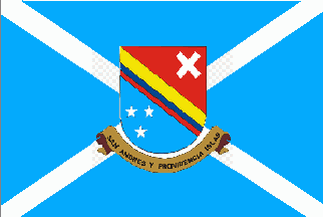
image by Chrystian Kretowicz, 1 October 2009
See also:
Above is a flag I got from the official web-page of the
Department of San Andres and Providencia at <www.sanandres.net>.
Andres Villaveces , 22 December 1999
IMHO, the saltire flag is clearly related to the main island's
name.
Antonio Martins , 23 December 1999
I manage <www.sanandres.net>
& <www.sanandres.com>.
I have lived on the island for 30 years and the petrolleum
green you describe (see Reported Wrong Flags)
as the official flag is wrong... the color is wrong... and the
black lines is also wrong.. the official flag is the one
you find on our site.... there is another version with the CoA
over the cross whre the white lines meet and much bigger.
Jimmy, 13 October 2000
I've stayed 3 wonderful days at this islands in Jan. 1999 and
that mentioned petroleum-green flag with black sided white cross
is not to be seen. Normally the flag is blue.
For those interested in the issue
"which-one-is-the-ground-colour" for San Andres Y
Providencia islands there is a pic showing neither
green-either-blue field, but a turquoise one...
More interesting is to note that the shade of blue in the CoA
seems to be a darker blue, much nearer those related to the
Colombian flag. I think that's pretty normal, since the strips in
the CoA are about the same order as in the Colombian flag, with
the yellow one larger too. The arms shown in the page are from a
lighter blue.
Gunter Zibell, 29 January 2001
I live on San Andres, although a "gringo". I
have never seen the green field flag you list as official. I have
seen the two blue field flags. There has been an
"evolution" on the island which may have had some
effect. In 1992 the "native" islaños took
official control of the island and thusly the official language
of the department is English. BUT, the official language of the
COUNTRY is Spanish. Thusly, it is the ONLY place in
Colombia where official documents may be in either Spanish or
English, and an English document does not need an official
Spanish translation. The flag MAY have undergone a change
with this change of control.
Tom Young, 18 December 2002
We previously showed a "Petroleum Green with white
diagonal lines in the shape of an X from corner to corner and
sorrounded by a black line" according to report by Andres
Villaveces. (see Reported Wrong Flags)
However, we had visitors reporting the flag as white saltire on
light blue.
Now, It seems that the first report is wrong.
Official site of the department <www.sanandres.gov.co>
clearly shows a white saltire on light blue and a variant in
which the CoA is in the cente.
Dov Gutterman, 28 March 2003
I can confirm it. Even if the petroleum green flag was also
reported in Gaceta de Banderas, this information is probably a
bad interpretation of the colour or based on a series of wrong
manufactured flags or some wrong printing. In Flag Report 29 ,
where all the departamental flags and CoA's (currant and past)
were reported, the flag of San Andres y Providencia is pictured
as light blue with white saltire and the green petroleum flag is
even not mentioned
Jaume Ollé, 29 March 2003
I have spent time in San Andres, Providencia and Santa
Catalina twice in ten years: five weeks in 1996 and two months in
2006. In addition, my father-in-law was from the island of
Providencia.
I was unable to find an example of the flag for sale there,
either of the tabletop variety or a full-size one. When I spoke
to the Alcalde (Mayor) of Providencia and Santa Catalina
on the subject, he told me that they were normally made to order
for the various official organisations in the islands. I have a photograph of me holding out
the flag of the archipelago from the flagpole on the Alcaldia
(Town Hall) of Providencia. The Alcalde, who was just
out of frame to the right, assured me that it was accurately made
to the official pattern.
The only other version of the flag I have seen, and that only
once at a school in San Andres, was of the same layout as the the
image provided by Jorge Candeias, but with the
pale blue colour of that in my photograph. I saw around a dozen
of the identical pattern to the one I am holding in the photo,
both in 1996 and 2006. I never once saw either version of the
poisonous "petroleum green" with black lines, nor the
dark blue variety.
Incidentally, all versions I recall seeing of the shield of arms
of the departamento (even on the registration sticker on
my sister-in-law's motor scooter) had the diagonal Greek
cross on the upper right in yellow, most versions with the
central square outline separating the arms of the cross, as on
the flag.
Carey Taylor-Forbes, 17 November 2007
I believe that the flag reported (with the photo) by Carey
Taylor-Forbes is the official one (light blue with the emblem in
the middle of the cross). It appears as such on the photo at:
<www.sanandres.gov.co>
(seventh photo down).
On the other hand the plain flag with the cross must be in use
too as evidenced on the same page ( 26th & 27th photos down
the page) where the Governor signs some deals with the visiting
Jamaicans. Strangely enough, the cross is very wide (wider than
Scotland's, I think).
Chrystian Kretowicz, 1 October 2009
sap.gif)
image by Andres Villaveces , 22 December 1999
The Official emblem of the department of San Andres and
Providencia which I got from <www.sanandres.net>.
Andres Villaveces, 22 December 1999
For the coat of Arms of the municipality of Providencia and
Santa Catalina, see <www.providencia-sanandres.gov.co>.
Felipe Carillo, 22 July 2008
Just for the record, San Andres and Providencia are two
colombian small islands off the atlantic coast of Nicaragua . ISO
lists this department as San Andrés, Providencia y Santa
Catalina.
António Martins, 23 December 1999
In 'Les Chiffres du Monde 1998' (Encyclopaedia Universalis
Yearbook 1998), San Andres & Providencia is listed as a
'regular' department, with capital San Andres. It is the smallest
department of Colombia, with an area of 44 square km (0.004% of
the total area of the country) and a population of 61,040
inhabitants (0.2% of the total population of the country), but
very crowdy, with a density of 1387 inhabitants/sq. km!
Ivan Sache, 26 December 1999
My maps are not coincident relatively to this. While most
consider this department as consisting only of the island of San
Andres, island of Providencia, cayos (rocks, or reefs) of Este
Sudeste and cayos of Albuquerque, another atlas, the one that is
more into showing internal divisions, extend the department into
the cayos of Quinta Suen~o, cayos of Roncador, Bank of Serrana,
Bank of Serranilla and Bajo Novo (a small reef, I suppose).
In any case, there is no Santa Catalina visible anywhere...
Jorge Candeias , 28 December 1999
Yes, there is. Read [San Andrés,] [Providencia y Santa
Catalina]. It is an islet just north of Providencia (AKA Old
Providencia) - Providencia is a kind of archipelago, with
Providencia Isl. in the south point and Santa Catalina in the
north. Most atlases I consulted have no name for the north
island; only Stielers Handatlas (1877) has a name. I made a scan of the area.
Jarig Bakker, 28 December 1999
The department includes the island of San Andrés,
Providencia, the islet of Santa Catalina and the Cayos (reefs) of
Este Sudeste, Albuquerque, Roncador, Quitasueño, Serrana, and
the banks of Serranilla and Bajo Nuevo. I'm also including a map also from the IGAC that shows
the department.
Andres Villaveces, 5 January 2000
On December 13, 2007 the International
Court of Justice issued a judgement regarding San Andrés y
Providencia Department dispute with Nicaragua It can be found
(and interpreted) at <www.icj-cij.org>.
For further information on the border dispute please see here.
E.R., 4 January 2008
Providencia is the only municipalitie of the department
because San Andres have special status as free port.
Felipe Carillo, 22 July 2008
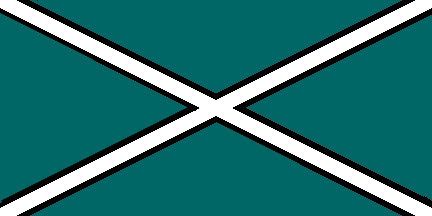
image by Andres Villaveces, 5 January 2000
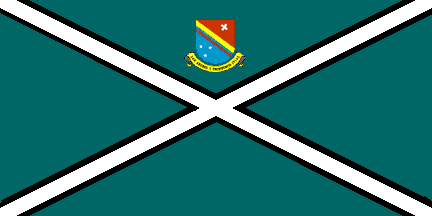
image by Blas Delgado Ortiz, 28 May 2000
I have contacted the Instituto Geografico Agustin Codazzi
(IGAC) (<http://www.igac.gov.co>).
The official geography institute of the government of Colombia
and they have verbally described the flag to me. I have made a
new file which resembles much more their description and I'm
including it here.
As described by the representative of the IGAC, the flag of San
Andrés is "Petroleum Green with white diagonal lines in the
shape of an X from corner to corner and sorrounded by a black
line.
The actual text of the email I received in Spanish says:
"En atención al e-mail del asunto, le comunico que la
bandera de San Andrés y Providencia es de color verde petroleo
con dos líneas diagonales formando una X de extremo a extremo en
color blanco y los bordes de la X van en color negro."
No mention of the emblem is made
Andres Villaveces , 5 January 2000
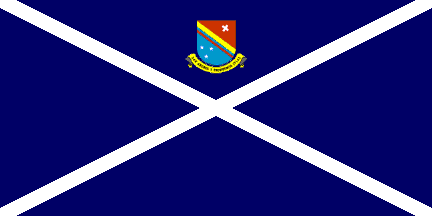
image by Jorge Candeias, 23 December 1999
Something puzzles me, though. To be noted first of all that
this page is not governmental, instead it's the flag of the
tourist board of the Department. It is official, no doubt, but
not from the kind of organism that pays more attention to flags.
Then what puzzles me: I have an image
taken from the web that shows a small flag of San Andres y
Providencia. It shows a lot of differences to the flag Andres
posted : for starters, the field is darker, about the same shade
as the scottish flag, then the cross is narrower, the proportions
are also different, seemingly in the 1:2 area, and finally the
coat of arms (COA) is present in the upper quadrant of the flag.
Now, what I'd like to ask to those who knows : which is the
official flag? Why the different shades of blue? Was there any
evolution in flag usage in the islands in recent years?
Jorge Candeias , 23 December 1999
Claimed by both the United States and Columbia. This is a
series of small cays located approximately 210 miles NNE of
Nicaragua. These islands were originally claimed by the US under
the Guano Act. Columbia considers this part of the Province
Archipelago (San Andres y Providencia). Additionally, Honduras
appears to have claimed this area as well.
Phil Nelson , 27 April 2000
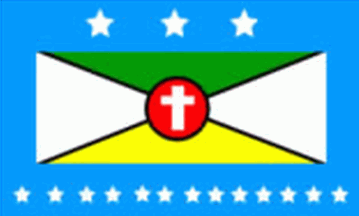
image by Chrystian Kretowicz, 1 October 2009
I've seen this flag
(Photo: Scott Dalton for The New York Times) in a "New
York Times" slide show. I presume it's the separatist
flag.
Fabien Antoine , 13 February 2008
There is a link to the relevant
article in the New York Times inclusing: "[...] But many
Raizals, as the English speakers here are known, feel loyalty
neither to Colombia, a Bush administration ally, nor to
Nicaragua, a supporter of President Hugo Chávez of Venezuela.
Nicaragua has claimed San Andrés in a bitter territorial
dispute, and while the two countries press their cases, a
nonviolent separatist movement is growing increasingly vocal
here. “This fight is taking place as if it were some
abstract matter over unpopulated atolls,” said Enrique Pusey
Bent, a director of the Archipelago Movement for Ethnic Native
Self-Determination, which symbolically declared independence last
June by replacing Colombia’s flags here."
Ivan Sache, 13 February 2008
I am not so sure that the NY Times got it right, at least
about the Flag. Of course there is an "Archipelago Movement
for Ethnic Native Self-Determination", AMEN-SD it is called.
You can find their web site at <www.amensd.org>,
but they usually parade under the Departamental Flag. In the
Gallery section of this web site you can see that.
Amen SD is closely associated with the Cristian University of San
Andres and with a protestant, baptist I believe, denomination. I
wonder if the Flag on the NY Times isn't more closely associated
with symbols form a certain denomination than with San Andres
Archipelago.
Nicolás Velásquez, 14 February 2008
The Raizal people blew the chance of staying separate in 1903,
when offered by the U.S. and done not much when they were an
absolute majority (65% in the sixties). Now, mere 30%, they
decided to go for it exploiting the dispute between Colombia and
Nicaragua to keep them in the relative spotlight. The
International Court of Justice in the Hague ruled in favor of
Colombia, but Nicaragua doesn't want to go along with it,
claiming some ambiguity of the verdict, especially when the
territorial waters around the islands are concerned.
The Archipelago Movement for Ethnic Native Self-Determination
(AMEN-SD) did, indeed, declare the independence of the Raizal
Nation in 2007 (see: <colombia.indymedia.org>.
AMEN-SD is a premier organization of the Raizal people, but,
obviously not of all of them. Its flag, proposed for the symbol
of the independent Raizal Nation, is fairly popular on the
islands (according to the photo evidence). More at: <www.amen-sd.org>
and <www.prensarural.org>
.
Presently, most of the the top departamental officials are
Raizals, including the Governor -Pedro Clavel Gallardo Forbes,
but obviously none in favor of independence.
The Raizals are primarily of African descent, speak Creole and
English (and Spanish of course, too) and are mainly Protestant,
in contrast to overwhelmingly Catholic Colombia. They number,
roughly, about 35, 000.
Chrystian Kretowicz, 1 October 2009




